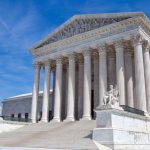Thanks to AI-generated content, it is becoming increasingly difficult to distinguish between a genuine photo and a fake one. That explains why a vintage US Army photo is once again circulating on social media, with some questioning its authenticity.
It shows a “tank” fitted with an oversized silencer.
The photo is real, but the device isn’t attached to the vehicle’s gun, nor is it fitted onto a tank; rather, the device is attached to a self-propelled howitzer. Of course, this only raises new questions, including why such an item was developed in the first place and whether it was effective.
The World’s Largest Gun Suppressor
The device in question was developed by German defense contractor Rheinmetall AG, working in coordination with the acoustic engineering laboratory IfL. The goal wasn’t to produce a silencer or suppressor for a tank on the move. Nor was the device intended for use by special ops teams who would employ it in battle on a tank—not that such vehicles are noted for being exactly “quiet” to begin with.
As the fact-checking website Snopes.com reported in 2022, the “muffler or suppressor” was developed for use at testing facilities, not for any “covert tank missions.” Snopes.com cited a report from IfL, which is no longer available online, that explained that the device was developed for the 120mm main gun employed on a Leopard 2 main battle tank. Therefore, there is a grain of truth that it was a “tank silencer.”
As with a suppressor for a rifle or handgun, the principle is very much the same. The device works by allowing the propellant gases produced by the blast to be sent into a tank or tube, which allows the pressure to decrease accordingly before being released.
Again, this device won’t silence the sound from the guns on tanks or even self-propelled artillery, and it certainly wasn’t designed for use on a battlefield. Instead, it was developed “to reduce the noise load from shots” fired by the weapons “in the vicinity of military testing facilities.” As with suppressors for small arms, the primary purpose is to reduce the volume, but anyone expecting a John Wick-style silencer will be very disappointed.
That answers the question about why the suppressor was developed and whether it worked. But the actual results weren’t exactly significant. The big gun muffler was reported to reduce the noise of the Leopard 2’s 120mm gun from approximately 115 decibels to 100 decibels for those who were located around 250 meters away. In other words, even with the muffler, the guns are still plenty loud.
What About Even Bigger Guns?
As noted by the photos that have gone viral, the muffler was also tested on the 155mm howitzer, a gun noted to be “one of the noisiest weapons” now in service across NATO. That presents problems when it is employed at firing ranges and training fields, where crews could be exposed to the blast noise for hours at a time.
The blast from a 155mm gun is reported to be around 180 decibels (dB), significantly louder than even a jet engine. The CDC (Centers for Disease Control) warns that prolonged exposure to noise above 70 dB can result in hearing damage, while noise at about 120 dB can cause immediate harm.
A general rule of thumb is that anything over 85 dB requires hearing protection, but no single product is effective against 180 dB, which may explain why Rheinmetall AG and IfL carried out the tests.
Tank Suppressors Are Not Practical
The photos of the device immediately highlight the impracticality of deploying it or similar suppressors in combat. Even a smaller muffler, tested at the Rock Island Arsenal (RIA) in Illinois in the 1960s with the 105mm gun on an M60, was impractically large. The muffler for the considerably smaller 105mm gun was a hollow 40-foot-long steel drum. It was barely suitable for the firing range, and obviously could not be employed in combat.
At best, suppressors and mufflers could, in theory, make the military firing range safer, but a far easier solution would be for the crews to wear more advanced hearing protection. Anyone near the 155mm gun when it is fired may need to wear dual protection that includes high-grade foam earplugs along with earmuffs.
Of course, photos of soldiers wearing hearing protection are a lot less interesting to share than those of an oversized “tank silencer.”
About the Author: Peter Suciu
Peter Suciu has contributed over 3,200 published pieces to more than four dozen magazines and websites over a thirty-year career in journalism. He regularly writes about military hardware, firearms history, cybersecurity, politics, and international affairs. Peter is also a Contributing Writer for Forbes and Clearance Jobs. He is based in Michigan. You can follow him on Twitter: @PeterSuciu. You can email the author: [email protected].
Image: Screenshot.
















